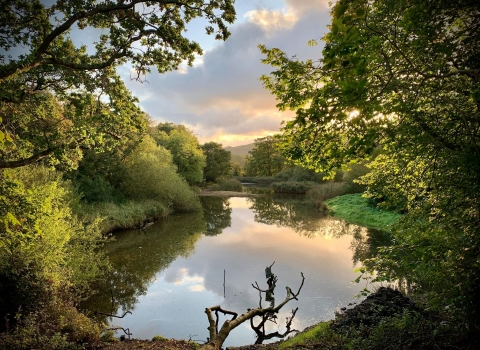
Emperor dragonfly female laying eggs - Ross Hoddinott 2020Vision

nightjar_David Tipling2020Vision

Kaya Parsons-Davies
Cors Bodgynydd Nature Reserve
Know before you go
Dogs
When to visit
Opening times
Open at all timesBest time to visit
Spring and summerAbout the reserve
The wide variety of wetland habitats at this remote, upland nature reserve in the Gwydir Forest were created when water levels were raised artificially in the nineteenth century to supply water for the mining industry. Lead and zinc were first mined here in 1625, spoil heaps and mineshafts still being visible today. The damming of the lakes has created areas of open water, mire, fen and bog littered with brightly coloured mats of sphagnum mosses. Many scarce species have been recorded here, including small chocolate-tip moth, lesser horseshoe bats and the insect-eating plant, lesser bladderwort. Dry, rocky ridges covered in heather, bilberry and rowan criss-cross the reserve, and provide handy vantage points from which to view wildlife.
Highland cows
The nutrient-poor and acidic wetland habitats at Cors Bodgynydd are dominated by purple moor grass, bog asphodel, bog myrtle, and bottle sedge. NWWT staff and volunteer groups, including those from the Snowdonia Society, manually clear conifers, birch, and willow regeneration and light Highland cattle grazing has been introduced to maintain the reserve’s open and wet character. Left unchecked, the area would eventually succeed to wet woodland. These management techniques also favour marsh clubmoss, the rare fern ally, which is threatened by changing patterns of habitat management and pollution and occurs in only four locations in Wales.
Did you know?
The world-famous Gwydir Mawr (formerly ‘Marin’) mountain bike trail passes nearby. With 17 miles of awesome scenery and 450m of climbing, why not combine some serious exercise with a lunch-stop at the nature reserve?
Directions
Heading West on the A5 from Betws-y-Coed, turn Right onto the single-track road at Tŷ Hyll (‘The Ugly House’). (Access is also possible leaving the B5106 SW of Llanrwst.) Take the first true Left (i.e. not onto a forest track), signposted ‘Llyn Geirionydd’. After approximately 0.6 miles, soon after some fenced-off mineshafts on the Right, there is a small, easily missed parking area on the Left with a kissing gate into the reserve (SH 766 597).



